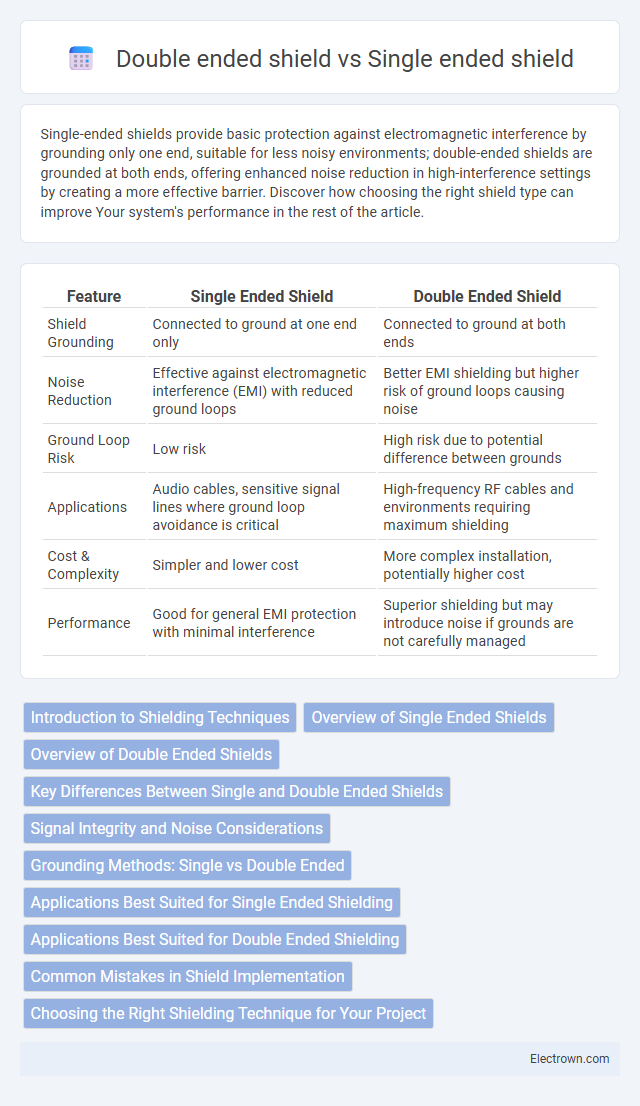Single-ended shields provide basic protection against electromagnetic interference by grounding only one end, suitable for less noisy environments; double-ended shields are grounded at both ends, offering enhanced noise reduction in high-interference settings by creating a more effective barrier. Discover how choosing the right shield type can improve Your system's performance in the rest of the article.
Table of Comparison
| Feature | Single Ended Shield | Double Ended Shield |
|---|---|---|
| Shield Grounding | Connected to ground at one end only | Connected to ground at both ends |
| Noise Reduction | Effective against electromagnetic interference (EMI) with reduced ground loops | Better EMI shielding but higher risk of ground loops causing noise |
| Ground Loop Risk | Low risk | High risk due to potential difference between grounds |
| Applications | Audio cables, sensitive signal lines where ground loop avoidance is critical | High-frequency RF cables and environments requiring maximum shielding |
| Cost & Complexity | Simpler and lower cost | More complex installation, potentially higher cost |
| Performance | Good for general EMI protection with minimal interference | Superior shielding but may introduce noise if grounds are not carefully managed |
Introduction to Shielding Techniques
Single ended shield uses a single conductor connected to ground, effectively reducing electromagnetic interference (EMI) in low-frequency applications. Double ended shield connects both ends of the shield to ground, providing superior protection against high-frequency noise and external interference. Your choice depends on desired noise attenuation, cable length, and environment sensitivity.
Overview of Single Ended Shields
Single ended shields provide a grounding method where the shield is connected to ground at one end only, minimizing ground loop noise in sensitive audio and data cables. This design reduces interference by preventing current flow through the shield, making it ideal for low-frequency signal integrity. Your equipment benefits from improved signal clarity and reduced electromagnetic interference with a single ended shield configuration.
Overview of Double Ended Shields
Double ended shields provide superior electromagnetic interference (EMI) protection by enclosing signals between two grounded shields, reducing noise pickup more effectively than single ended shields. Commonly used in high-frequency or sensitive electronic applications, these shields maintain signal integrity by minimizing crosstalk and external interference. Their design ensures consistent impedance and enhanced durability, making them ideal for complex wiring systems in aerospace, medical, and communication industries.
Key Differences Between Single and Double Ended Shields
Single-ended shields feature one connection point to ground, minimizing noise interference in simpler setups, while double-ended shields connect to ground at both ends, providing enhanced protection against electromagnetic interference (EMI) for complex or high-frequency environments. The primary difference lies in the grounding method, with single-ended reducing ground loops but offering less comprehensive shielding compared to double-ended shields that create a continuous protective barrier. Understanding these distinctions helps you select the optimal shield type for your specific electrical or signal integrity needs.
Signal Integrity and Noise Considerations
Single-ended shield cables provide basic noise reduction by protecting the signal conductor from external electromagnetic interference, enhancing signal integrity primarily in low-frequency applications. Double-ended shield cables offer superior noise immunity by grounding the shield at both ends, effectively minimizing ground loop interference and maintaining higher signal integrity in complex or high-frequency environments. Choosing between single-ended and double-ended shield configurations depends on the specific noise environment, frequency range, and grounding scheme to optimize signal quality and reduce electromagnetic interference.
Grounding Methods: Single vs Double Ended
Single-ended shield grounding involves connecting the shield to ground at only one end, minimizing ground loop currents and reducing noise interference in low-frequency applications. Double-ended shield grounding connects both ends of the shield to ground, enhancing high-frequency noise suppression but increasing the risk of ground loops and potential signal distortion. Selection depends on balancing noise reduction needs with grounding integrity and environmental noise conditions.
Applications Best Suited for Single Ended Shielding
Single ended shielding is best suited for applications requiring basic electromagnetic interference (EMI) protection with simpler grounding schemes, such as consumer electronics and audio equipment where cost-efficiency and ease of implementation are priorities. It is commonly used in environments with low to moderate EMI, providing adequate noise suppression for single-ended signal transmissions found in analog audio, instrumentation, and automotive wiring. Single ended shielding ensures reliable performance in systems where the shield is grounded at one end to prevent ground loops and minimize signal degradation.
Applications Best Suited for Double Ended Shielding
Double ended shielding is best suited for high-frequency and sensitive electronic applications where maximum noise reduction and electromagnetic interference (EMI) protection are critical, such as in aerospace, medical devices, and advanced communication systems. This shielding technique provides enhanced signal integrity by enclosing cables or components on both ends, effectively minimizing ground loops and crosstalk. Industries requiring stringent EMI compliance and superior signal performance prioritize double ended shielding to ensure reliability and precision.
Common Mistakes in Shield Implementation
Common mistakes in shield implementation include improper grounding of single-ended shields, which can cause ground loops and introduce noise rather than reduce it. Double-ended shields often face issues when both ends are grounded without proper isolation, leading to unintended current flow and electromagnetic interference. Ensuring the correct grounding method based on system design and signal type is crucial to maximizing shield effectiveness.
Choosing the Right Shielding Technique for Your Project
Choosing the right shielding technique for your project depends on factors like signal integrity, noise reduction, and environmental interference. Single-ended shielding offers basic protection suitable for low-interference environments, while double-ended shielding provides enhanced noise rejection by grounding both cable ends, ideal for high-frequency or sensitive applications. Ensuring your cable shielding matches the electromagnetic compatibility requirements can significantly improve performance and reduce signal degradation in your system.
Single ended shield vs Double ended shield Infographic

 electrown.com
electrown.com